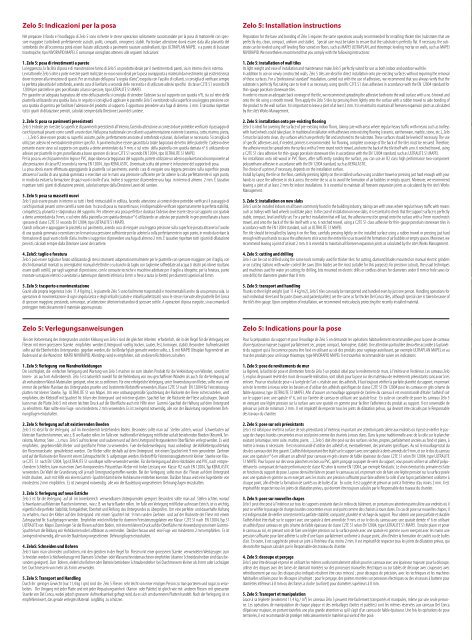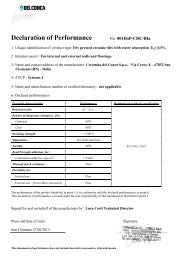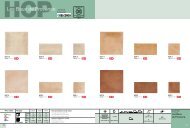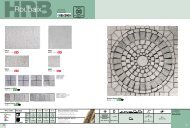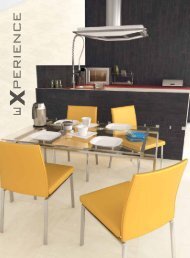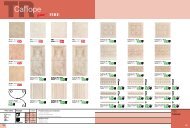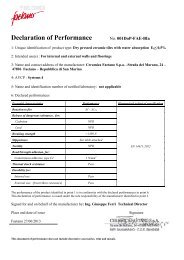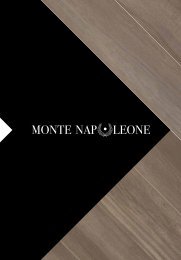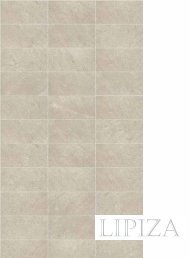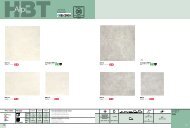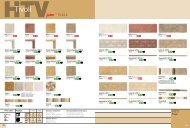LA PORCELLANA D'ARREDO RETTIFICATA ... - Del Conca
LA PORCELLANA D'ARREDO RETTIFICATA ... - Del Conca
LA PORCELLANA D'ARREDO RETTIFICATA ... - Del Conca
You also want an ePaper? Increase the reach of your titles
YUMPU automatically turns print PDFs into web optimized ePapers that Google loves.
Zelo 5: Indicazioni per la posa<br />
Nel preparare il fondo e l’incollaggio di Zelo 5 sono richieste le stesse operazioni solitamente raccomandate per la posa di mattonelle con spessore<br />
maggiore (sottofondi perfettamente asciutti, puliti, compatti, omogenei, stabili. Particolare attenzione dovrà essere data alla planarità del<br />
sottofondo che all’occorrenza potrà essere lisciato utilizzando a pavimento rasature autolivellanti, tipo ULTRAP<strong>LA</strong>N MAPEI, e a parete di lisciature<br />
tissotropiche, tipo NIVORAPID MAPEI. È comunque consigliato attenersi alle seguenti indicazioni:<br />
1. Zelo 5: posa di rivestimenti a parete<br />
La leggerezza, la facilità di posa e di manutenzione fanno di Zelo 5 un prodotto ideale per il rivestimento di pareti, sia in interno che in esterno.<br />
Le mattonelle Zelo 5 oltre a poter rivestire pareti realizzate ex-novo sono ideali per la posa sovrapposta a materiali da rivestimento già esistenti senza<br />
dover ricorrere alla rimozione di questi. Per un risultato della posa “a regola d’arte”, eseguita con l’ausilio di collanti, si consiglia di verificare sempre<br />
la perfetta planarità del sottofondo, avendo cura di livellarlo a seconda delle necessità e di utilizzare adesivi specifici di classe C2TE S1 secondo EN<br />
12004 per piastrelle in gres porcellanato a basso spessore, tipo ULTRALITE S1 MAPEI.<br />
Per garantire un’adeguata bagnatura del retro della piastrella si consiglia di stendere l’adesivo sia sul supporto con spatola n°6, sia sul retro della<br />
piastrella utilizzando una spatola liscia. In seguito si consiglia di applicare le piastrelle Zelo 5 esercitando sulla superficie una leggera pressione con<br />
una spatola di gomma per facilitare l’adesione del prodotto al supporto. È opportuno prevedere una fuga di almeno 2 mm. È tassativo rispettare<br />
tutti i giunti di dilatazione previsti, calcolati sempre dalla Direzione Lavori del cantiere.<br />
2. Zelo 5: posa su pavimenti preesistenti<br />
Zelo 5 è ideale per rivestire la superficie di pavimenti preesistenti all’interno, facendo attenzione ai contesti dove potrebbe verificarsi il passaggio di<br />
carichi puntuali pesanti come carrelli a ruote dure. Nella posa tradizionale con collanti su pavimentazione esistente (ceramica, cotto, marmo, pietra,<br />
…), Zelo 5 deve essere posato su superfici asciutte, pulite, perfettamente ancorate al sottofondo e planari, da livellare se necessario. Si consiglia di<br />
utilizzare adesivi ed eventualmente primer specifici. A pavimento,deve essere garantita la totale bagnatura del retro delle piastrelle. L’adesivo deve<br />
pertanto essere steso sul supporto con spatola a dente arrotondato da 9 mm, e sul retro della piastrella con spatola dentata n° 6 utilizzando un<br />
adesivo per piastrelle in gres porcellanato a basso spessore di classe C2TE S1 secondo EN 12004, tipo ULTRALITE S1 MAPEI.<br />
Per la posa su vecchi pavimenti in legno e PVC, dopo idonea carteggiatura del supporto, potrete utilizzare un adesivo poliuretanico bicomponente ad<br />
alte prestazioni di classe R2 secondo la norma EN 12004 , tipo KERA<strong>LA</strong>STIC. L’eventuale scelta del primer è in funzione del supporto di posa.<br />
La posa dovrà essere effettuata appoggiando la piastrella sul pavimento, avendo cura di eseguire una leggera pressione sulla superficie posata<br />
attraverso l’ausilio di una spatola gommata o esercitare con le mani una pressione sufficiente per far aderire la colla perfettamente in ogni punto,<br />
in modo da evitare la formazione di spazi vuoti o bolle d’aria. Inoltre si suggerisce di prevedere una fuga in interno di almeno 2 mm. È tassativo<br />
rispettare tutti i giunti di dilatazione previsti, calcolati sempre dalla Direzione Lavori del cantiere.<br />
3. Zelo 5: posa su massetti nuovi<br />
Zelo 5 può essere posato in interno su tutti i fondi rintracciabili in edilizia, facendo attenzione ai contesti dove potrebbe verificarsi il passaggio di<br />
carichi puntuali pesanti come carrelli a ruote dure. In caso di posa su massetti nuovi, è indispensabile verificare opportunamente la perfetta stabilità,<br />
compattezza, planarità e stagionatura del supporto. Per ottenere una posa perfetta e duratura l’adesivo deve essere steso sul supporto con spatola<br />
a dente arrotondato da 9 mm, e sul retro della piastrella con spatola dentata n° 6 utilizzando un adesivo per piastrelle in gres porcellanato a basso<br />
spessore di classe C2TE S1 secondo EN 12004, tipo ULTRALITE S1 MAPEI.<br />
Quindi collocare e appoggiare la piastrella sul pavimento, avendo cura di eseguire una leggera pressione sulla superficie posata attraverso l’ausilio<br />
di una spatola gommata o esercitare con le mani una pressione sufficiente per far aderire la colla perfettamente in ogni punto, in modo da evitare la<br />
formazione di spazi vuoti o bolle d’aria. Inoltre si suggerisce di prevedere una fuga di almeno 2 mm. È tassativo rispettare tutti i giunti di dilatazione<br />
previsti, calcolati sempre dalla Direzione Lavori del cantiere.<br />
4. Zelo5: taglio e foratura<br />
Zelo 5 può essere tagliato e forato utilizzando gli stessi strumenti adoperati normalmente per le piastrelle con spessore maggiore: per il taglio, con<br />
dischi diamantati montati su smerigliatrici manuali elettriche o su banchi da taglio con taglierine raffreddate ad acqua (i dischi più idonei risultano<br />
essere quelli sottili); per tagli sagomati di precisione, con le consuete tecniche e macchine adottate per il taglio a idrogetto; per la foratura, punte<br />
montate su trapani elettrici o avvitatori a batteria per diametri inferiori a 8 mm o frese a tazza (o foretti) per diametri superiori ad 8 mm.<br />
5. Zelo 5: trasporto e movimentazione<br />
Grazie alla propria leggerezza (solo 11,4 Kg/mq.), le piastrelle Zelo 5 sono facilmente trasportabili e movimentabili anche da una persona sola. Le<br />
operazioni di movimentazione di ogni singola lastra e degli imballi (scatole e imballi pallettizzati) sono le stesse riservate alle piastrelle <strong>Del</strong> <strong>Conca</strong><br />
di spessore maggiore, prestando, comunque, un’attenzione ulteriore trattandosi di spessore sottile. A operazioni di posa eseguite, si raccomanda di<br />
proteggere meticolosamente il materiale appena posato.<br />
Zelo 5: Verlegungsanweisungen<br />
Bei der Vorbereitung des Untergrundes und der Klebung von Zelo 5 sind die gleichen Arbeiten erforderlich, die in der Regel für die Verlegung von<br />
Fliesen mit einer groesseren Staerke empfohlen werden (Untergrund voellig trocken, sauber, fest, homogen, stabil). Besondere Aufmerksamkeit<br />
sollte auf die Ebenheit des Untergrundes gegeben werden, die bei Bedarf glatt gemacht werden sollte, z. B. mit MAPEI Ultraplan Fugenmörtel am<br />
Boden und an die Wand mit MAPEI NIVORAPID. Allerdings wird es empfohlen, sich an diesen Richtlinien zu halten:<br />
1. Zelo 5: Verlegung von Wandverkleidungen<br />
Die Leichtigkeit, die einfachen Verlegung und Wartung von Zelo 5 machen sie zum idealen Produkt für die Verkleidung von Wänden, sowohl im<br />
Innen- als auch im Außenbereich. Zelo 5 ist natuerlich sowohl für die Verkleidung von neu geschaffenen Wänden als auch für die Verlegung auf<br />
alt vorhandenen Wand-Materialien geeignet, ohne sie zu entfernen. Für eine erfolgreiche Verlegung, unter Anwendung von Kleber, sollte man erst<br />
immer die perfekte Planitaet des Untergrundes pruefen und bestimmte Klebstoffe verwenden, Klasse C2TE S1 nach EN 12004 für Feinsteinzeugplatten<br />
mit kleiner Staerke, Typ ULTRALITE S1 von Mapei. Um eine ordnungsgemäße Spachtelung der Rückseite der Fliese sicherzustellen, wird<br />
empfohlen, den Klebstoff mit Spachtel Nr. 6 fuer den Untergrund und mit einer glatten Spachtel fuer die Rückseite der Fliese aufzutragen. Danach<br />
kann man die Platte Zelo 5 mit einem leichten Druck auf die Oberfläche auch mit Hilfe einer Gummi-Spachtel die Haftung auf dem Untergrund<br />
zu erleichtern. Man sollte eine Fuge von mindestens 2 mm verwenden. Es ist zwingend notwendig, alle von der Bauleitung vorgesehenen Dehnungsfugen<br />
einzuhalten.<br />
2. Zelo 5: Verlegung auf alt existierenden Boeden<br />
Zelo 5 ist ideal für die Verlegung auf im Innenbereich bestehenden Böden. Besonders sollte man auf Stellen achten, worauf Schwerlasten auf<br />
kleinsten Flaechen kommen, wie z. B. wo Raeder rollen. Im Falle von traditioneller Verlegung mit Kleber auf alt bestehenden Boeden (Keramik, Terrakotta,<br />
Marmor, Stein ...), muss Zelo 5 auf trockenen und sauberen und auf dem Unetrgrund festgeankerten Oberflächen verlegt werden. Es wird<br />
empfohlen, gegebenenfalls Kleber und spezifische Primer zu verwenden. Fuer die Bodenverlegung muss unbedingt die Vollkleberspachtelung<br />
der Fliesenrueckseite gewährleistet werden. Der Kleber sollte deshalb auf dem Untergrund mit einem Spachtel mit 9 mm gerundeten Zaehnen<br />
und auf der Rückseite der Fliese mit einem Zahnspachtel Nr. 6 aufgetragen werden. Klebstoff für Feinsteinzeugplatten mit kleiner Staerke von Klasse<br />
C2TE S1 nach EN 12004, Typ ULTRALITE S1 von Mapei sollte verwendet werden. Für die Verlegung auf alten Holzböden und PVC, nach entsprechendem<br />
Schleifen, kann man einen Zwei-Komponenten-Polyurethan-Kleber mit hoher Leistung von Klasse R2 nach EN 12004, Typ KERA<strong>LA</strong>STIC<br />
verwenden. Die Wahl der Grundierung soll je nach Untergrund getroffen werden. Bei der Verlegung sollte man die Fliesen auf dem Untergrund<br />
leicht drucken, auch mit Hilfe von einem Gummi-Spachtel damit keine Hohlraeume entstehen koennen. Darüber hinaus wird eine Fugenbreite von<br />
mindestens 2 mm empfohlen. Es ist zwingend notwendig, alle von der Bauleitung vorgesehenen Dehnungsfugen einzuhalten.<br />
3. Zelo 5: Verlegung auf neue Estriche<br />
Zelo 5 ist für die Verlegung auf all im Innenbereich verwendbaren Untergruenden geeignet. Besonders sollte man auf Stellen achten, worauf<br />
Schwerlasten auf kleinsten Flaechen kommen, wie z. B. wo harte Raeder rollen. Im Falle von Verlegung mit Kleber auf neuen Estrich, ist es wichtig,<br />
eigentlich die perfekte Stabilität, Kompaktheit, Ebenheit und Reifung des Untergrundes zu überprüfen. Um eine perfekte und dauerhafte Haftung<br />
zu erhalten, muss der Kleber auf den Untergrund mit einem Spachtel mit 9 mm runden Zaehnen und auf der Rückseite der Fliese mit einem<br />
Zahnspachtel Nr. 6 aufgetragen werden. Empfohlen wird ein Kleber für duennen Feinsteinzeugplatten von Klasse C2TE S1 nach EN 12004, Typ S1<br />
ULTRALITE von Mapei. Dann legen Sie die Fliesen auf dem Boden, mit einem kleinen Druck auf die Oberfläche mit Anwendung von einem Gummi-<br />
Spachtel um die Bildung von Hohlräumen oder Luftblasen zu vermeiden. Darüber hinaus wird eine Fuge von mindestens 2 mm empfohlen. Es ist<br />
zwingend notwendig, alle von der Bauleitung vorgesehenen Dehnungsfugen einzuhalten.<br />
4. Zelo5: Schneiden und Bohren<br />
Zelo 5 kann man schneiden und bohren, mit den gleichen in der Regel für Fliesen mit einer groesseren Staerke verwendeten Werkzeugen: zum<br />
Schneiden werden Schleifwerkzeuge mit Diamant-Scheiben oder Wasserschneidemaschinen empfohlen (duenne Schneidescheiben sind dazu besonders<br />
geeignet). Zum Bohren, elektrische Bohrer oder Batterie betriebene Schraubendreher bei Durchmessern kleiner als 8 mm oder Lochsägen<br />
bei Durchmessern von mehr als 8 mm verwenden.<br />
5. Zelo 5: Transport und Handling<br />
Durch ihr geringes Gewicht (nur 11,4 kg / qm) sind die Zelo 5 Fliesen sehr leicht von einer einzigen Person zu transportieren und sogar zu verarbeiten.<br />
Der Umgang mit jeder Platte und mit jeder Verpackungseinheit (Karton oder Palette) ist gleich wie mit anderen Fliesen mit groesseren<br />
Staerke von <strong>Del</strong> <strong>Conca</strong>, wobei jedoch groessere Aufmerksamkeit gefragt wird, da es sich um duenneren Platten handelt. Nach der Verlegung, ist es<br />
empfehlenswert, das gerade verlegtes Material sorgfältig zu schützen.<br />
Zelo 5: Installation instructions<br />
Preparation for the base and bonding of Zelo 5 requires the same operations usually recommended for installing thicker tiles (substrates that are<br />
perfectly dry, clean, compact, uniform and stable). Special care must be taken to ensure that the substrate is perfectly flat. If necessary, the substrate<br />
can be leveled using self leveling floor screed on floors, such as MAPEI ULTRAP<strong>LA</strong>N, and thixotropic leveling mortar on walls, such as MAPEI<br />
NIVORAPID. We nonetheless recommend that you comply with the following instructions:<br />
1. Zelo 5: installation of wall tiles<br />
Its light weight and ease of installation and maintenance make Zelo 5 perfectly suited for use as both indoor and outdoor wall tile.<br />
In addition to use on newly constructed walls, Zelo 5 tiles are ideal for direct installation onto pre-existing surfaces without requiring the removal<br />
of these surfaces. For a “professional standard” installation, carried out with the use of adhesives, we recommend that you always verify that the<br />
substrate is perfectly flat, taking care to level it as necessary, using specific C2TE S1 class adhesives in accordance with the EN 12004 standard for<br />
thin-gauge porcelain stoneware tiles.<br />
In order to ensure an adequate back coverage of the tile, we recommend spreading the adhesive both onto the wall surface with a no. 6 trowel and<br />
onto the tile using a smooth trowel. Then apply the Zelo 5 tiles by pressing them lightly onto the surface with a rubber trowel to aide bonding of<br />
the product to the wall surface. It is important to leave a joint of at least 2 mm. It is essential to maintain all foreseen expansion joints as calculated<br />
by the site’s Works Management.<br />
2. Zelo 5: installation onto pre-existing flooring<br />
Zelo 5 is ideal for covering the surface of pre-existing indoor floors, taking care with areas where regular heavy traffic with means such as trolleys<br />
with hard wheels could take place. In traditional installation with adhesives onto existing flooring (ceramic, earthenware, marble, stone, etc.), Zelo<br />
5 must be laid onto clean, dry surfaces which are perfectly flat and anchored to the substrate. These surfaces should be leveled if necessary. The use<br />
of specific adhesives and, if needed, primers is recommended. For flooring, complete coverage of the back of the tiles must be ensured. Therefore,<br />
the adhesive must be spread onto the surface with a 9 mm round notch trowel, and onto the back of the tile itself with a no. 6 notched trowel, using<br />
a C2TE S1 class adhesive for thin-gauge porcelain stoneware tiles in accordance with the EN 12004 standard, such as ULTRALITE S1 MAPEI.<br />
For installation onto old wood or PVC floors, after sufficiently sanding the surface, you can use an R2 class high performance two-component<br />
polyurethane adhesive in accordance with the EN 12004 standard, such as KERA<strong>LA</strong>STIC.<br />
The choice of a primer, if necessary, depends on the installation surface.<br />
Install by laying the tile on the floor, carefully pressing lightly on the installed surface using a rubber trowel or pressing just hard enough with your<br />
hands to cause the adhesive to stick across the entire tile so as to avoid the formation of air bubbles or empty spaces. Moreover, we recommend<br />
leaving a joint of at least 2 mm for indoor installations. It is essential to maintain all foreseen expansion joints as calculated by the site’s Works<br />
Management.<br />
3. Zelo 5: installation on new slabs<br />
Zelo 5 can be installed indoors on all bases commonly found in the building industry, taking care with areas where regular heavy traffic with means<br />
such as trolleys with hard wheels could take place. In the case of installation on new slabs, it is essential to check that the support surface is perfectly<br />
stable, compact, level and fully set. For a perfect installation that will last, the adhesive must be spread onto the surface with a 9 mm round notch<br />
trowel, and onto the back of the tile itself with a no. 6 notched trowel, using a C2TE S1 class adhesive for thin-gauge porcelain stoneware tiles in<br />
accordance with the EN 12004 standard, such as ULTRALITE S1 MAPEI.<br />
The tile should be installed by laying it on the floor, carefully pressing lightly on the installed surface using a rubber trowel or pressing just hard<br />
enough with your hands to cause the adhesive to stick across the entire tile so as to avoid the formation of air bubbles or empty spaces. Moreover, we<br />
recommend leaving a joint of at least 2 mm. It is essential to maintain all foreseen expansion joints as calculated by the site’s Works Management.<br />
4. Zelo 5: cutting and drilling<br />
Zelo 5 can be cut or drilled using the same tools normally used for thicker tiles: for cutting, diamond blades mounted on manual electric grinders<br />
or on cutting stations with water-cooled tile saws (thin blades are the most suitable for this purpose); for precision cutouts, the usual techniques<br />
and machines used for water jet cutting; for drilling, bits mounted on electric drills or cordless drivers for diameters under 8 mm or hole saws (or<br />
core drills) for diameters greater than 8 mm.<br />
5. Zelo 5: transport and handling<br />
Thanks to their light weight (just 11.4 kg/m2), Zelo 5 tiles can easily be transported and handled even by just one person. Handling operations for<br />
each individual sheet and for packs (boxes and packed pallets) are the same as for thicker <strong>Del</strong> <strong>Conca</strong> tiles, although special care is taken because of<br />
the tile’s thin gauge. Upon completion of installation, we recommend meticulously protecting the recently installed material.<br />
Zelo 5: Indications pour la pose<br />
Pour la préparation du support et pour l’encollage de Zelo 5 on demande les opérations habituellement recommandées pour la pose de carreaux<br />
d’une épaisseur majeure (support parfaitement sec, propre, compact, homogène, stable). Une attention particulière devra être accordée à la planéité<br />
du support qui à l’occurrence pourra être lissé en utilisant au sol des produits pour ragréage autolissant, par exemple ULTRAP<strong>LA</strong>N MAPEI, et au<br />
mur des produits pour un lissage thixotrope, type NIVORAPID MAPEI. Il est toutefois recommandé de suivre ces indications:<br />
1. Zelo 5: pose de revêtements de mur<br />
La légèreté, la facilité de pose et d’entretien font de Zelo 5 un produit idéal pour le revêtement de murs, à l’intérieur et l’extérieur. Les carreaux Zelo<br />
5, en plus de pouvoir revêtir des murs de nouvelle réalisation, sont idéals pour la pose sur des matériaux de revêtements préexistants sans avoir à les<br />
enlever. Pour un résultat de pose « à la règle de l’art », réalisée avec des adhésifs, il faut toujours vérifier la parfaite planéité du support, en prenant<br />
soin de le mettre à niveau selon les besoins et d’utiliser des adhésifs spécifiques de classe C2TE S1 EN 12004 pour les carreaux en grès cérame de<br />
faible épaisseur, type ULTRALITE S1 MAPEI. Afin d’assurer un mouillage approprié de l’arrière du carreau il est recommandé d’étaler l’adhésif soit<br />
sur le support avec une spatule n° 6, soit sur l’arrière de carreau en utilisant une spatule lisse. En suite on conseille de poser les carreaux Zelo 5<br />
en exerçant une légère pression sur la surface avec une spatule en gomme pour faciliter l’adhérence du produit au support. Il est convenable de<br />
prévoir un joint de minimum 2 mm. Il est impératif de respecter tous les joints de dilatation prévus, qui devront être calculés par le Responsable<br />
des travaux du chantier.<br />
2. Zelo 5: pose sur sols préexistants<br />
Zelo 5 est idéal pour revêtir la surface de sols préexistants à l’intérieur, en portant une attention particulière aux endroits où il peut se vérifier le passage<br />
de charges lourdes concentrées en un seul point comme des chariots à roues dures. Dans la pose traditionnelle avec de la colle sur le plancher<br />
existant (céramique, terre cuite, marbre, pierre, ...), Zelo 5 doit être posé sur des surfaces sèches, propres, parfaitement ancrées au fond et plates, à<br />
mettre à niveau si nécessaire. Il est recommandé d’utiliser des adhésifs et, éventuellement, des primaires spécifiques. Au sol le mouillage total du<br />
dos des carreaux doit être garanti. L’adhésif doit pourtant être étalé sur le support avec une spatule à dents arrondis de 9 mm, et sur le dos du carreau<br />
avec une spatule n° 6 en utilisant un adhésif pour carreaux en grès cérame de faible épaisseur de classe C2TE S1 selon EN 12004, type ULTRALITE<br />
S1 MAPEI. Pour la pose sur des vieux planchers en bois ou PVC, après ponçage au papier de verre du support, vous pouvez utiliser un adhésif polyuréthane<br />
bi-composant de haute performance de classe R2 selon la norme EN 12004, par exemple Keralastic. Le choix éventuel du primaire est faite<br />
en fonction du support de pose. La pose devra être faite en posant le carreau au sol, en prenant soin de faire une légère pression sur la surface posée<br />
avec une spatule en gomme ou en exerçant avec les mains une pression suffisante pour faire adhérer la colle d’une façon parfaitement uniforme à<br />
chaque point, afin d’éviter la formation de cavités ou de bulles d’air. En outre, il est suggéré de prévoir un joint à l’intérieur d’au moins 2 mm. Il est<br />
impératif de respecter tous les joints de dilatation prévus, qui devront être toujours calculés par le Responsable des travaux du chantier.<br />
3. Zelo 5: pose sur nouvelles chapes<br />
Zelo 5 peut être posé à l’intérieur sur tous les supports existants dans le milieu du bâtiment, en portant une attention particulière aux endroits où il<br />
peut se vérifier le passage de charges lourdes concentrées en un seul point comme des chariots à roues dures. En cas de pose sur nouvelles chapes, il<br />
est indispensable de vérifier correctement la parfaite stabilité, compacité, planéité et séchage du support. Pour obtenir une pose parfaite et durable<br />
l’adhésif doit être étalé sur le support avec une spatule à dent arrondi de 9 mm, et sur le dos du carreau avec une spatule dentée n° 6 en utilisant<br />
un adhésif pour carreaux en grès cérame de faible épaisseur de classe C2TE S1 selon EN 12004, type ULTRALITE S1 MAPEI. Ensuite placer et poser<br />
le carreau au sol, en prenant soin de faire une légère pression sur la surface posée avec une spatule en gomme ou en exerçant avec les mains une<br />
pression suffisante pour faire adhérer la colle d’une façon parfaitement uniforme à chaque point, afin d’éviter la formation de cavités ou de bulles<br />
d’air. En outre, il est suggéré de prévoir un joint à l’intérieur d’au moins 2 mm. Il est impératif de respecter tous les joints de dilatation prévus, qui<br />
devront être toujours calculés par le Responsable des travaux du chantier.<br />
4. Zelo 5: decoupe et perçage<br />
Zelo 5 peut être découpé et percé en utilisant les mêmes outils normalement utilisés pour les carreaux avec une épaisseur majeure: pour la découpe,<br />
utiliser des disques avec des lames de diamant montées sur des ponceuses manuelles électriques ou sur tables de découpe avec coupeuses avec<br />
refroidissement par eau (les disques plus indiqués résultent être ceux minces) ; pour découpes de précision, avec les techniques et les machines<br />
habituelles utilisées pour les découpes à hydrojet ; pour le perçage, des pointes montées sur perceuses électriques ou des visseuses à batterie pour<br />
diamètres inférieurs à 8 mm ou des fraises à cloche (ou foret) pour diamètres supérieurs à 8 mm.<br />
5. Zelo 5: Transport et manipulation<br />
Grace à sa légèreté (seulement 11,4 kg / m²) les carreaux Zelo 5 peuvent être facilement transportés et manipulés, même par une seule personne.<br />
Les opérations de manipulation de chaque plaque et des emballages (boites et palettes) sont les mêmes réservées aux carreaux <strong>Del</strong> <strong>Conca</strong><br />
d’épaisseur majeure, en portant toutefois une plus grande attention vu qu’il s’agit d’un carreau de faible épaisseur. Une fois les opérations de pose<br />
terminées, il est recommandé de protéger méticuleusement le matériel qui vient d’ être posé.<br />
Thermatile® è l’innovativo sistema brevettato<br />
di riscaldamento radiante in fibra di carbonio,<br />
di soli 4 millimetri di spessore per riscaldare senza gas, caldaia e<br />
manutenzioni, facile da installare, gestire e programmare. Applicabile<br />
in tutti gli ambienti ha uno spessore di gran lunga inferiore a qualsiasi<br />
altro sistema. La fibra di carbonio è sovrapposta ad una striscia di materiale<br />
isolante e disposta a serpentina sulla rete di supporto.<br />
I vantaggi di Thermatile®<br />
rispetto ad un comune<br />
riscaldamento radiante<br />
ad acqua:<br />
• SPESSORE LIMITATISSIMO, CIRCA 4 MM<br />
• MINORE COSTO DELL’IMPIANTO<br />
• RAPIDITÀ, SEMPLICITÀ ED ECONOMICITÀ<br />
DELL’INSTAL<strong>LA</strong>ZIONE (PUÒ ESSERE ESEGUITA<br />
DAL PIASTRELLISTA)<br />
• ASSENZA DI MANUTENZIONE<br />
Thermatile® is the innovative patented<br />
carbon fiber radiant heating system.<br />
Just 4 millimeters thick, it heats without needing<br />
gas, a boiler or maintenance. Easy to install,<br />
manage and program. It can be installed in any<br />
kind of room and boasts a thickness that is by<br />
far less than any other system. The carbon fiber<br />
is placed on a layer of insulating material and<br />
arranged in coils on the support mesh.<br />
The advantages of Thermatile®<br />
radiant heating:<br />
• SUBSTANTIALLY REDUCED GAUGE, ABOUT 4 MM<br />
• LOWER COST OF THE SYSTEM<br />
• FAST, EASY AND LOW INSTAL<strong>LA</strong>TION COST<br />
(IT CAN BE INSTALLED BY THE TILE <strong>LA</strong>YER)<br />
• MAINTENANCE FREE<br />
• NO WATER CIRCU<strong>LA</strong>TING IN THE WALLS OR FLOORS<br />
MEANING NO LEAKS<br />
• NO SPACE-EATING BOILERS, FLUES, OR CHIMNEYS<br />
• IT DOESN’T USE NATURAL GAS, WHICH ISN’T<br />
AVAI<strong>LA</strong>BLE EVERYWHERE, OR ANY OTHER FUEL,<br />
ELIMINATING THE RISKS INVOLVED WITH GAS USE,<br />
AS WELL AS THE NEED TO DEAL WITH THE GAS<br />
COMPANY<br />
• HEATS FASTER BECAUSE IT IS P<strong>LA</strong>CED DIRECTLY<br />
BELOW THE FLOOR OR WALL SURFACE<br />
• INTELLIGENT MANAGEMENT THROUGH AN EASY<br />
TO USE CONTROL PANEL OR PROGRAMMABLE<br />
THERMOSTAT: BY AREA, WITH TEMPERATURE<br />
ADJUSTMENT DURING THE DAY/WEEK, WITH<br />
OCCASIONAL USE, ETC.<br />
• IT CAN BE USED AS A SUPPLEMENT TO TRADITIONAL<br />
HEATING SYSTEMS FOR INCREASED COMFORT<br />
(“WARMER IN THE BATHROOM” EFFECT), AS WELL AS<br />
BE SET ON A SCHEDULE AND BE USED OUTSIDE OF THE<br />
HOURLY AND DAILY SCHEDULE OF CENTRAL HEATING<br />
SYSTEMS...)<br />
• ASSENZA DI ACQUA CIRCO<strong>LA</strong>NTE NEI MURI E NEL PAVIMENTO E<br />
DELLE POSSIBILI PERDITE<br />
• MANCANZA DELL’INGOMBRO DI CALDAIA, CANNE FUMARIE, COMIGNOLI<br />
• NON IMPIEGA GAS, NON DISPONIBILE OVUNQUE, NÉ ALTRO<br />
COMBUSTIBILE, EVITANDO I RISCHI CONNESSI E <strong>LA</strong> GESTIONE DEL<strong>LA</strong><br />
RE<strong>LA</strong>TIVA UTENZA<br />
• MAGGIORE VELOCITÀ DI RISCALDAMENTO PERCHÈ POSIZIONATO<br />
IMMEDIATAMENTE SOTTO AL PAVIMENTO O RIVESTIMENTO<br />
• MAGGIORE SEMPLICITÀ DI UNA GESTIONE INTELLIGENTE TRAMITE CENTRALINA O<br />
CRONOTERMOSTATO: PER ZONE, CON MODU<strong>LA</strong>ZIONE DEL<strong>LA</strong> TEMPERATURA DURANTE<br />
<strong>LA</strong> GIORNATA/SETTIMANA, CON UTILIZZO SALTUARIO, ECC...<br />
• POSSIBILITÀ DI IMPIEGO AD INTEGRAZIONE DI IMPIANTI TRADIZIONALI PER AUMENTARE<br />
IL COMFORT (EFFETTO “PIÙ TEPORE IN BAGNO”), ANCHE CON PROGRAMMAZIONE ORARIA,<br />
UTILIZZO FUORI DAGLI ORARI E DAL<strong>LA</strong> CALENDARIZZAZIONE DEGLI IMPIANTI CENTRALIZZATI,...)<br />
Thermatile® ist ein innovatives patentiertes<br />
Strahlungsheizungssystem aus<br />
Kohlefasern, nur 4 Millimeter stark um ohne<br />
Gas, Kessel- und Wartung zu heizen, einfach<br />
zu installieren, zu verwalten und zu programmieren.<br />
In allen Raeumen verwendbar, hat eine<br />
Staerke kleiner als jedes anderes System. Die<br />
Kohlenfaser steht auf ein tragendes und gleichzeitig<br />
wärmedämmendes Netz.<br />
Die Vorteile der Thermatile®<br />
im Vergleich zu einem herkoemmlichen<br />
Wasser-Strahlungsheizungssystem:<br />
• KLEINSTE STAERKE VON NUR CA. 4 MM<br />
• GERINGERE INSTAL<strong>LA</strong>TIONSKOSTEN<br />
• SCHNELLE, EINFACHE UND KOSTENSPARENDE<br />
INSTAL<strong>LA</strong>TION (KANN VON FLIESENLEGER<br />
AUSGEFUEHRT WERDEN))<br />
• KEINE WARTUNG<br />
• KEINE WASSERROEHREN IN DEN WÄNDEN UND<br />
IN DEN BOEDEN MIT DEN DAMIT VERBUNDENEN<br />
MOEGLICHEN WASSERSCHAEDEN<br />
• KEINE HEIZUNGSKESSEL, SCHORNSTEINE, KAMINE<br />
• KEIN RISIKOREICHES ERDGAS ODER ANDERE NICHT<br />
UEBERALL VORHANDENEN BRENNSTOFFEN<br />
• SCHNELLERE HEIZUNGSWIRKUNG, WEIL DIREKT<br />
UNTER DEM BODEN ODER DER WAND INSTALLIERT.<br />
• EINFACHE NUTZUNG DURCH DAS INTELLIGENTE<br />
THERMOSTAT-STEUERN VON EINZELNEN RAEUMEN<br />
ODER MIT ZEITSTEUERUNG (TAG, WOCHEN USW.)<br />
• ALS ERGAENZUNG VON TRADITIONELLEN<br />
HEIZUNGSAN<strong>LA</strong>GEN (“MEHR WÄRME IN BAD”) UND<br />
VERWENDUNG AUSSERHALB DER GESETZLICHEN<br />
ODER ZENTRALISIERTEN HEIZUNGSP<strong>LA</strong>N.<br />
Thermatile® est l’innovateur système<br />
breveté de chauffage radiant en fibre de<br />
carbone, de seulement 4 millimètres d’épaisseur<br />
pour réchauffer sans gaz, chaudière et entretiens,<br />
facile à installer, gérer et programmer. Applicable<br />
dans tous les milieux ayant une épaisseur de<br />
loin inférieur à n’importe quel autre système. La<br />
fibre de carbone est superposée à une bande de<br />
matériel isolant et disposée en serpentin sur le<br />
réseau de support.<br />
Les avantages de Thermatile® par<br />
rapport à un chauffage commun<br />
radiant à eau:<br />
• EPAISSEUR TRES LIMITEE, ENVIRON 4 MM<br />
• COUT MINEUR DE L’INSTAL<strong>LA</strong>TION<br />
• RAPIDITÉ, SIMPLICITE ET ÉCONOMIE DE<br />
L’INSTAL<strong>LA</strong>TION (PEUT ÊTRE EXÉCUTÉE PAR LE<br />
CARRELEUR).<br />
• ABSENCE D’ENTRETIEN.<br />
• ABSENCE D’EAU CIRCU<strong>LA</strong>NT DANS LES MURS, DANS<br />
LE P<strong>LA</strong>NCHER ET DES POSSIBLES PERTES.<br />
• PAS D’ENCOMBREMENT DE <strong>LA</strong> CHAUDIERE, DE<br />
TUYAU DE CHEMINEE ET CHEMINEE<br />
• N’UTILISE PAS LE GAZ, QUI N’EST PAS DISPONIBLE<br />
PARTOUT, NI TOUT AUTRE COMBUSTIBLE EN EVITANT<br />
LES RISQUES ASSOCIES À <strong>LA</strong> GESTION DE SON<br />
UTILISATEUR.<br />
• C’EST UN CHAUFFAGE PLUS RAPIDE CAR IL EST<br />
POSITIONNE IMÉDIATEMENT SOUS LE P<strong>LA</strong>NCHER OU<br />
AU REVÊTEMENT.<br />
• TRES GRANDE SIMPLICITE D’UNE GESTION<br />
INTELLIGENTE DE CONTROLE OU PAR<br />
CHRONOTHERMOSTA DES ZONES AVEC MODU<strong>LA</strong>TION<br />
DE <strong>LA</strong> TEMPÉRATURE PENDANT <strong>LA</strong> JOURNEE / SEMAINE,<br />
POUR UNE FAIBLE UTILISATION.<br />
• <strong>LA</strong> POSSIBILITÉ D’EMPLOI À INTÉGRER DES<br />
INSTAL<strong>LA</strong>TIONS TRADITIONNELLES AFIN D’AUGMENTER<br />
LE COMFORT (EFFET « PLUS DE CHALEUR DANS <strong>LA</strong><br />
SALLE DE BAIN »), MÊME AVEC PROGRAMMATION<br />
HORAIRE, ET EN DEHORS DES HEURES D’UTILISATION<br />
PAR L’INSTAL<strong>LA</strong>TION CENTRALISÉE.


